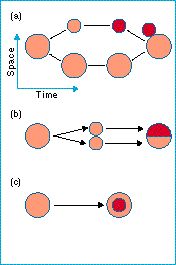Speciation

Speciation is the process in which a new species is formed from an initial one.
The following events must happen in the origin of a new species:
1. There is a single species, made up of a set of interbreeding organisms.
2. A genetic variant must spread through part of the species and the bearers of this variant must mate only with other bearers of the same variant.
3. The species will have now split into two: from one initial population, two separate interbreeding populations will have evolved. Along the way, further phenetic, behavioral and ecological differences may also evolve.
The crucial event, for the origin of a new species, is reproductive isolation. Biologists need to understand how a barrier to interbreeding can evolve between the new species and its ancestors.
There are three main theories as to how this can happen:
• Allopatric speciation in which the new species evolves in geographic isolation from its ancestor.
• Parapatric speciation: the new species evolves in a geographically contiguous population.
• Sympatric speciation: the new species evolves within the geographic range of its ancestor.
Figure: the three main theories of speciation. (a) allopatric, (b) parapatric and (c) sympatric.
| Next |



